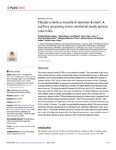Mostrar o rexistro simple do ítem
Fibularis tertius muscle in women & men: A surface anatomy cross-sectional study across countries
| dc.contributor.author | López-López, Daniel | |
| dc.contributor.author | Losa Iglesias, Marta Elena | |
| dc.contributor.author | Becerro-de-Bengoa-Vallejo, Ricardo | |
| dc.contributor.author | Rodríguez Sanz, David | |
| dc.contributor.author | Palomo-López, Patricia | |
| dc.contributor.author | Navarro Flores, Emmanuel | |
| dc.contributor.author | Calvo-Lobo, César | |
| dc.date.accessioned | 2022-03-11T11:36:43Z | |
| dc.date.available | 2022-03-11T11:36:43Z | |
| dc.date.issued | 2019-04 | |
| dc.identifier.citation | Palomo-López P, Losa-Iglesias ME, Calvo-Lobo C, Rodríguez-Sanz D, Navarro-Flores E, Becerro-de-Bengoa-Vallejo R, et al. (2019) Fibularis tertius muscle in women & men: A surface anatomy cross-sectional study across countries. PLoS ONE 14(4): e0215118. https://doi.org/10.1371/journal.pone.0215118 | es_ES |
| dc.identifier.uri | http://hdl.handle.net/2183/29959 | |
| dc.description.abstract | [Abstract] The fibularis tertius muscle (FTM) is a rare anatomic variation. The prevalence of this exclusively human structure, which is found in the anterior compartment of the leg, is often underestimated, and it is believed that foot and ankle conditions are more difficult to manage in patients with an FTM. The aim of this study was to assess the presence of the FTM palpation and determine whether its presence is associated with an individual’s sex, because the exact prevalence in males and females is unclear. An observational cross-sectional study was carried out. The study included 481 people (23.49% men and 76.51% women) with a mean age of 23.51±5.369 years, who were recruited from a Podiatric Medicine and Surgery Clinic (Spain). Data on routine demographic and clinical factors were recorded, and the presence or absence of the FTM was determined based on surface visual or palpated localization of the tendon (using a consistent protocol). The FTM was present in 38.25% (184/481) of the participants. Furthermore, FTM were present in 38.6% (142/481) of females and 37.2% (42/481) of males. The study revealed that the presence of the FTM varies between individuals and does not depend on an individual’s sex. Significant differences in the prevalence of the FTM between countries should be carefully evaluated rather than generalizing the results of this Spanish study to other non-Spanish populations. Larger numbers of participants should be enrolled in future studies in order to meet the statistical criteria. | es_ES |
| dc.language.iso | eng | es_ES |
| dc.publisher | PLOS | es_ES |
| dc.relation.uri | https://doi.org/10.1371/journal.pone.0215118 | es_ES |
| dc.rights | Atribución 3.0 España | es_ES |
| dc.rights.uri | http://creativecommons.org/licenses/by/3.0/es/ | * |
| dc.subject | Muscle functions | es_ES |
| dc.subject | Funciones musculares | es_ES |
| dc.subject | Body weight | es_ES |
| dc.subject | Peso corporal | es_ES |
| dc.subject | Tendones | es_ES |
| dc.subject | Tendons | es_ES |
| dc.subject | Ankle | es_ES |
| dc.subject | Tobillo | es_ES |
| dc.subject | Foot | es_ES |
| dc.subject | Pie | es_ES |
| dc.title | Fibularis tertius muscle in women & men: A surface anatomy cross-sectional study across countries | es_ES |
| dc.type | info:eu-repo/semantics/article | es_ES |
| dc.rights.access | info:eu-repo/semantics/openAccess | es_ES |
| UDC.journalTitle | Plos One | es_ES |
| UDC.volume | 14 | es_ES |
| UDC.issue | 4 | es_ES |
| UDC.startPage | e0215118 | es_ES |
Ficheiros no ítem
Este ítem aparece na(s) seguinte(s) colección(s)
-
GI-UDISAP - Artigos [193]






